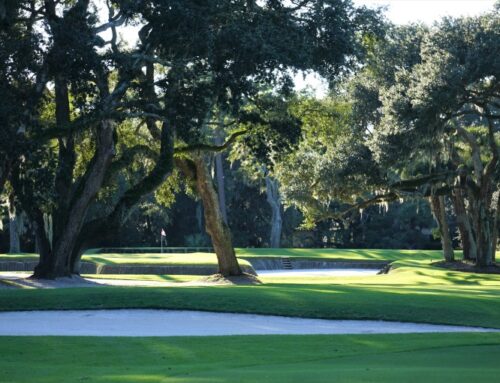Trinity Forest Golf Club
Texas, United States of America

Hard to believe but one of America’s most ‘links-like’ playing experiences is found 8 miles south of Dallas, Texas.
Can you imagine calling Bill Coore and saying, “I have a ‘special site’ that I would like you to see” when in fact you were referring to land laid upon two decommissioned landfills south of Dallas separated by a highway?! Jonas Woods, a co-founder and the club’s developer, did just that. And so begins the Trinity Forest story. Indeed, it is a particularly interesting one on two fronts. First, finding 200+ acres so close to downtown Dallas would otherwise be impossible and what the sport needs the most are courses that are intertwined with the daily fabric of one’s life. Trinity Forest ticks that box. Additionally, in terms of turning nothing (i.e. fallow landfills) into something special, it is – literally – the epitome of great architecture.
Naturally Coore and Crenshaw were reluctant to tour the site, assuming Woods didn’t understand what a ‘special site’ should offer. After a few of Crenshaw’s Dallas friends encouraged him to see it, he agreed to drive up from Austin to walk the site. Crenshaw, in his reserved manner, commented that the site was “interesting” but didn’t offer much more. A couple days after that visit, Coore contacted Woods and asked if he too could visit the site passing along that his partner had found it “interesting.” After spending a few hours with Woods and Harrison Frazer trudging through tall grasses, Coore knew what needed to happen. After discussing the site and his idea with Crenshaw, Coore asked if they could come back in a week and tour the site together, however they needed Woods to take care of one thing beforehand. “Can you mow the site?” asked Coore. Woods didn’t understand why (assuming maybe the walk was too difficult and slow because of the long grass), however, if that would improve the chances of landing Coore & Crenshaw as architects, he would take care of it.
Upon their return, as they walked from what is now the clubhouse to the elevated area on which the first and tenth tees are now found, Coore and Crenshaw turned to Woods and unveiled why the site needed to be mowed. The long grasses obscured what they both could feel in their feet as they walked, the ground was wrinkled, moving up and down like a shirt that needed to be ironed. With the site mowed, standing on the teeing ground looking out across the meadow, Coore called Woods’ attention to the now revealed pot-marked, rumpled landscape and said “That’s golf, and we’d like to design this course.”
Though land like that might hold little appeal to most pursuits, ‘rumpled’ and ‘golf’ are a potential match made in heaven. Ironically, the landfill’s virtue was that it wasn’t particularly well done, meaning that much had settled unevenly over the decades. A special assembly would be required to build an appealing course across a landfill – and Woods so organized. Coore & Crenshaw would design the course, Jim Barger of Oncore would be the construction manager and the Green Keeper would be Kasey Kauff, formerly from the Atlantic Athletic Club and the Country Club of Orlando. Kauff’s presentation for the 2011 PGA Championship at the Highlands Course at Atlanta Athletic Club had been sterling and helped establish the then 31 year old as a preeminent Green Keeper of warm weather grasses.
The transaction itself of building a club on land owned by the city through a private investment was plenty complicated. So was building a course on top of a debris landfill! Law stipulated that there be a minimum two feet of undisturbed cap across the entire property, requiring 750,000 cubic yards (!) of fill to be hauled in. No cuts could be performed, the course had to be built up. Crucially, trucks didn’t just come in and dump the fill. Each truck load was inspected for content. If the soil had any sandy loam qualities at all, it was directed toward a tee, fairway or green. If it was heavier clay (of the sort Texas is famous for), it went to the rough areas. And if it was gravelly/rocky, it went to what would become native areas. Much of a Green Keeper’s ultimate success is based on what is below the surface, and Kauff pounced on the unique circumstances that allowed him to influence the soil distribution across the site.
Construction started and the property grew ‘taller’ with time. If Coore was entranced by a low spot in the fairway, by the time the sandy loam was deposited, the rest of the area had to be built up to preserve the depression. Relative to bunker construction, allowances had to be made for drainage tiles, then the floor of the bunker and up from there, always mindful that two feet of cap had to exist below everything. This was assuredly a painstaking process but ultimately define the project’s resounding success. By in large, today’s rumpy-bumpy features mimic what was originally there before the required fill was brought in.
Enough on the construction – what about the golf itself? That is what matters. Overall, Coore & Crenshaw knew the winning formula would be the same as their other projects: Provide room off the tee and then heighten the challenge at the green. Still, Coore & Crenshaw had the monumental task of making each hole look and play different. Normally, nature provides wonderful distinct landforms to help take care of that issue but not here. Therefore, much of the project’s success rested on man to create interesting hazards and putting surfaces.
To write that Coore & Crenshaw nailed it hardly ruins the suspense because if not, this profile wouldn’t exist. In terms of hazards (the time honored expression that includes bunkers), Coore & Crenshaw have always created handsome ones (thanks often to Jeff Bradley who was part of the Trinity Forest team) but that is an aesthetic. The crucial thing here was their placement and that is where they excelled. Bunkers are routinely found in the middle of fairways or aggressively intrude into the landing zone from one side of the fairway or the other. This is simply as it should be, yet rarely is in America. To put bunkers merely on the sides of holes to discipline an already wayward shot is nonsensical. Why punish the inept? Bunkers in the path between the tee and green are far more relevant and interesting to all players than those meekly positioned on the sides.
Anyone fortunate to have played overseas has experienced the virtue of fairway bunkers (i.e. a bunker completely surrounded by fairway) as they play much bigger than their actual footprint as short grass helps them attract balls from all directions and from well away. American golfers in particular became accustomed to the design notion in the last half of the 20th century that bunkers should flank the playing corridors and that the fairway represent ‘fair passage’ down the playing corridor. What rubbish! The Old Course at St. Andrews made that abundantly clear by the time Old Tom Morris had finished tweaking it. The roster of winners at The Old Course including Jones, Nicklaus, and Woods stands as testimony to the fact that central and cross hazards identify both the best driver as well as tactician.

Coore & Crenshaw invariably placed something between the player and the hole that must be overcome, including here at the reachable uphill 5th.
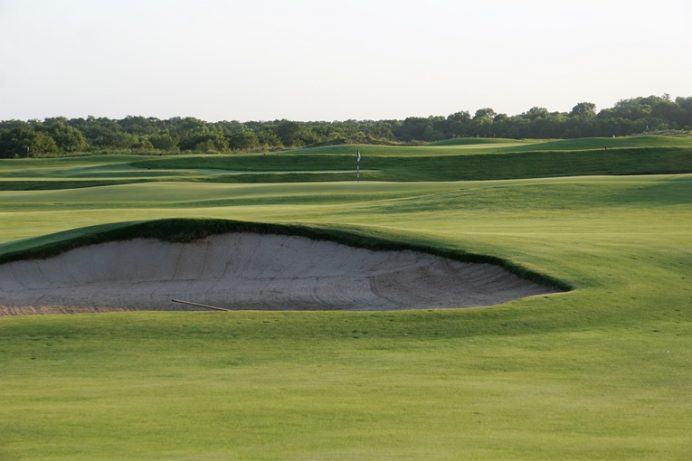
Smack in the middle of the 6th fairway, this bunker is precisely where most golfers wish it were not.
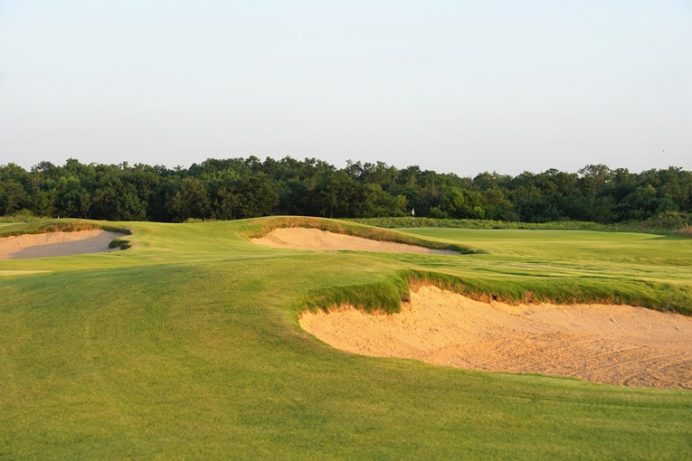
The 10th fairway pivots around a nest of bunkers on the inside of the dogleg.
Regarding green contours, the set at Trinity Forest rivals the best that Coore & Crenshaw have produced. That’s a mighty statement, but an accurate one, pushed to the pinnacle by the firm surfaces presented by Kauff and crew. Coore has long contended that the most important area of a course – and often times, the most overlooked – is the area 20 yards and in to the putting surface. If that isn’t interesting, then the course won’t be either. Trinity Forest’s greens and their surrounds are cumulatively excellent, brought to full fruition by Kauff who was adamant that a new strain of Zoysia be employed. Indeed, the strain they went with is now known as Trinity Zoysia and as Coore describes it, ‘This is the closest thing to fescue of any warm weather grass. It is as good as it gets for this climate.’
Just how good is it? A video circulated of Kauff walking down a fairway ‘dribbling’ a golf ball a few days before the first PGA Tour event was held in May, 2018. Indeed, the Tour beseeched the club to slow down the playing surfaces before the event. At the time, Coore thought it was the fastest playing inland course he had ever seen. Applause all around to everyone involved. The three successive photographs below convey how the green contours alternate from pronounced to rippling.
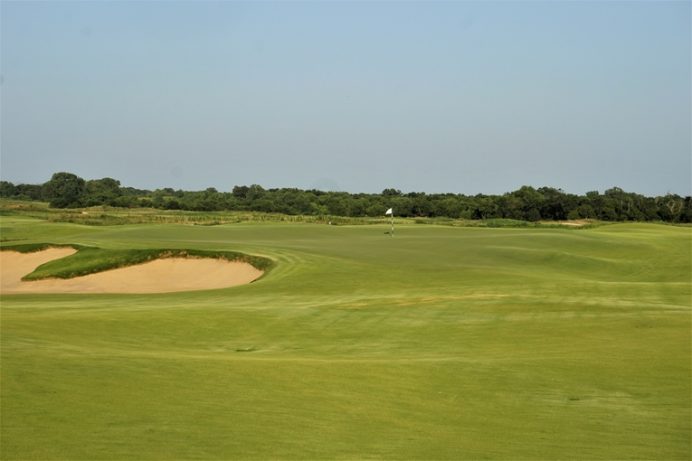
The 1st green tells it all: the dramatic false front, the back right bowl and a bodacious three foot ridge that tracks along the rear.
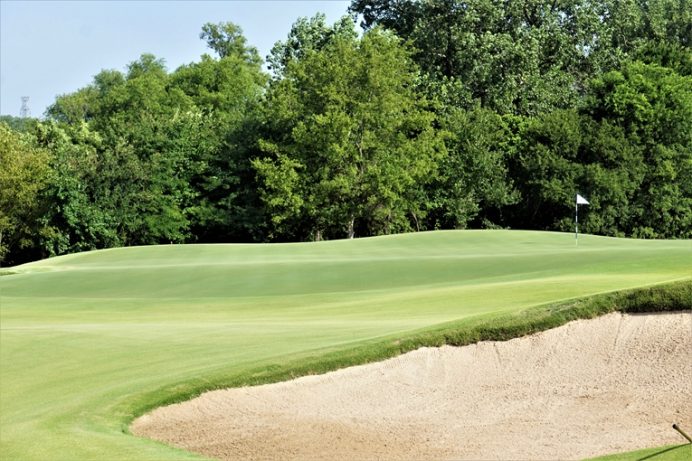
Strong contours and a right to left cant define the challenge at the 9th.

This view from behind the 10th green toward the clubhouse confirms that the focus of a game at Trinity Forest is on the land. One and two feet rises engage and befuddle the Old Trooper.
The course and playing conditions ultimately dovetailed together in a spectacular fashion. Yet, one more crucial element remained, namely the environment needed to feel authentic. If it reeked of artificiality, who would opt to spend their leisure time in a contrived environment? The shrewd decision was made to reestablish what is known as ‘blackland prairie’ throughout the native areas. This was the dominant ecological system in this part of Texas before urban sprawl smothered it. Over 40 varietals of grasses now exist across the property. These hardy plants don’t require tender care and their color is reflective of the weather: green-ish when it rains and beige when it doesn’t. The author is enthralled by the overall playing environment, with sweeping, long, uninterrupted views (as seen in the lead photograph to this profile) akin to those at Walton Heath and Garden City. The fact that the property is buffeted by the Trinity Audubon Center, the Joppa Preserve and McCommas Bluff on three sides sets the stage for a tranquil playing experience. Highway 12 is removed to the north and overall, the player revels in a pure golf landscape.
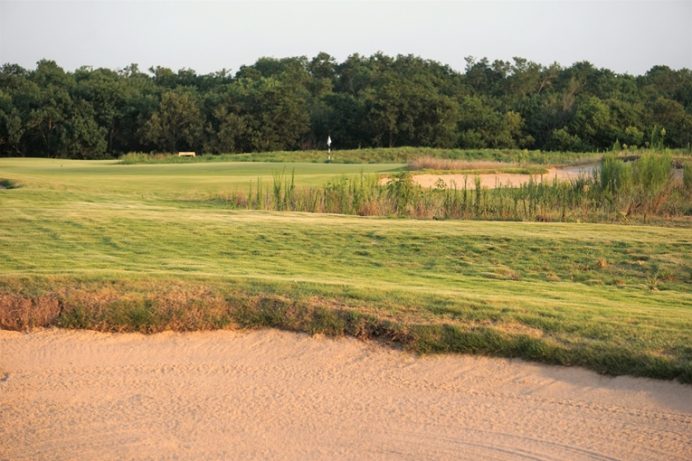
Golf in the state of Texas, augmented by the reinstatement of blackland prairie.
Tees range anywhere from 5,899 to 7,558 yards. The ones referenced below are the Blue markers, which measure 7,092 yards. Normally, GolfClubAtlas doesn’t list such tees as the distance precludes a snappy three hour round. Not here. Set over a mere 140 acres, this Coore & Crenshaw design is among their most compact. Play is brisk and the firm playing surfaces make the 7,000+ yards manageable even for a 6 handicap.
As we scroll through the holes below, note how design influences creep in from some of Bill Coore and Ben Crenshaw’s all-time favorite courses, including the West Course at Royal Melbourne, The Old Course at St. Andrews, and Pinehurst No. 2. Such bodes well, yes?
Holes to Note
Second hole, 205 yards; This green, the fifth, tenth and fifteenth share the distinction of being the only ones that don’t either brush up against the perimeter or the wash. Their lack of framing makes each hard to hit. Take the photograph below. The distant trees define the property’s perimeter and are over 350 yards away from the back edge of the green. Yet, as the course itself was built up from its surrounds, whatever wind exists – and Texas is a windy state – will have a say on the outcome of most shots. Additionally, the ‘greenside’ bunker isn’t, meaning it is pulled off the putting surface by a dozen paces. Gaining depth perception and a sense for the wind prove elusive, especially this early in the round. First timers routinely come up woefully short here when the breeze is against.
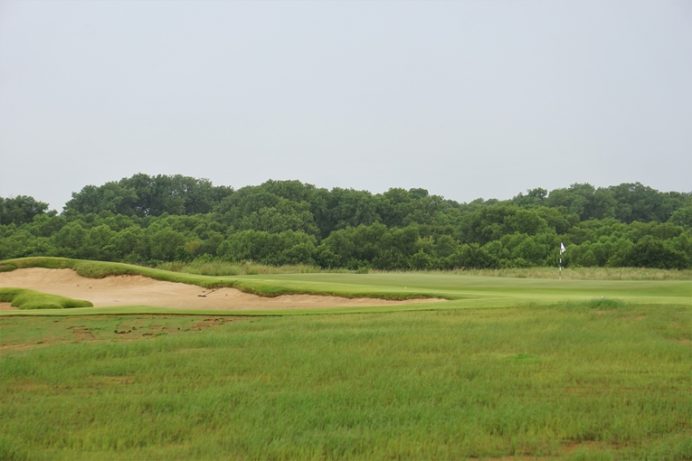
The 2nd seems straightforward but there is a lot going on that isn’t immediately evident.
Third hole, 385 yards; The only way Trinity Forest was going to work was with hazards between the player and the green, so no surprise to find this 50 yard wide bunker directly blocking the path from tee to green, posing all sorts of conundrums. Does the golfer lay up short of the hazard or flirt with going around for the sake of a shorter approach? Some days, downwind, he might even take a crack at carrying it. So many options off the tee guarantee that the hole remains fresh to play on a regular basis. Indeed, Trinity Forest would be half as interesting to play if it wasn’t for its thought provoking bunkering scheme.
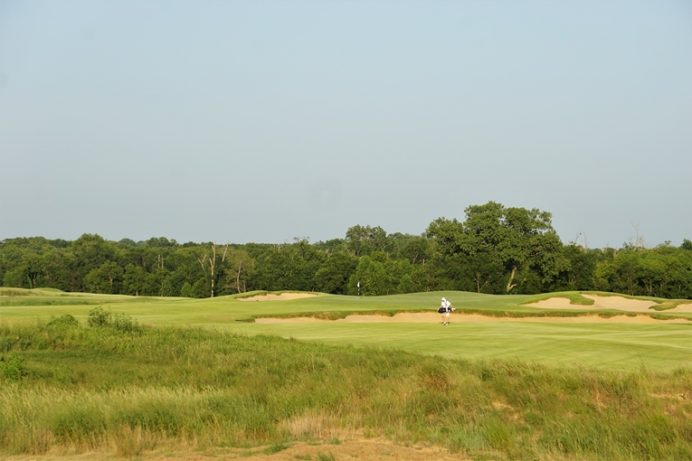
Short, left or long of this cross hazard? Each golfer must decide.
Fourth hole, 425 yards; The first of the perimeter holes, the fourth heads east with a sharp drop-off right. Often times, holes with a falloff tend to have relatively flat fairways. Such is not true here. The scalloped contours create trepidation as a hard first bounce right can send a tee ball careening toward the edge. Coore & Crenshaw’s architecture (i.e. the threat of being shunted right) layered on with Kauff’s skills (i.e. the guarantee that the ball will spring right) allows the tee shot to prey on the tiger’s psyche. The cold, hard fact is that the player is not afforded the luxury of being in control of his ball once it lands at Trinity Forest. This is the opposite of a ‘hit and splat’ course or a ‘point-to-point’ design. Therefore, the PGA players had a love/hate relationship with it when they played here in 2018 and 2019. Meanwhile, those of us who worship links golf and seeing balls skeeter along the ground, adore Trinity Forest. Too many courses don’t stir the soul; the fact that this design is polarizing/misunderstood is actually a huge compliment.
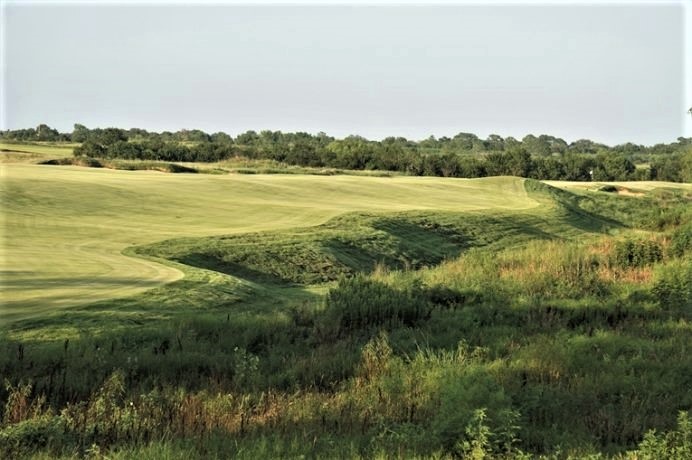
The flag right beckons but prudence dictates aiming for the bunker high on the left.
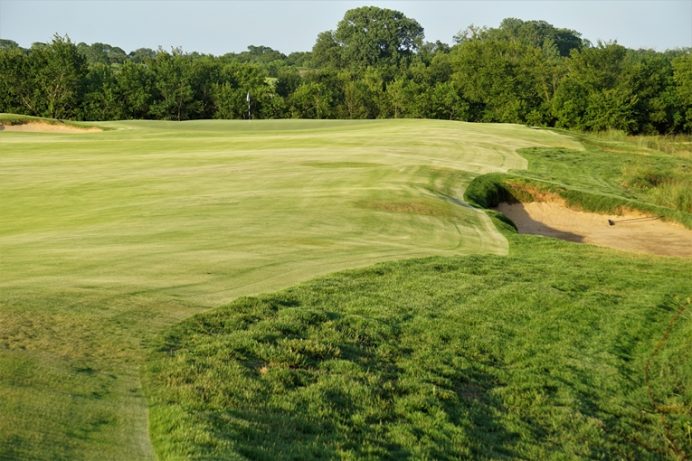
The green is gently puffed up from its surrounds and accepts all sorts of approach shots. Note the attractive fairway sheen – it even looks fast!
Fifth hole, 285 yards; Drivable short par 4s are a Coore & Crenshaw staple and this is one of their best as it highlights that often the simpler the design, the better. There are two key components. First, a large bunker punctuates the fairway 60 yards shy of the green. Second, the domed green is fittingly the hardest target to hit – and hold – on the course. The bunker placement is superb – it is just close enough to the tee that the golfer is confident that he can carry it – until he doesn’t. The resulting awkward length bunker shot is hated by all skill sets, especially here as the green’s false front and soft sides delight in sending balls away. The confident golfer on the tee becomes morose when his rash tactics backfire. A hybrid off the tee might well be the smart play week-in, week-out but where is the fun in that?! Certain things will never make sense in life, like a dog biting its tail or golfers always pulling driver here.
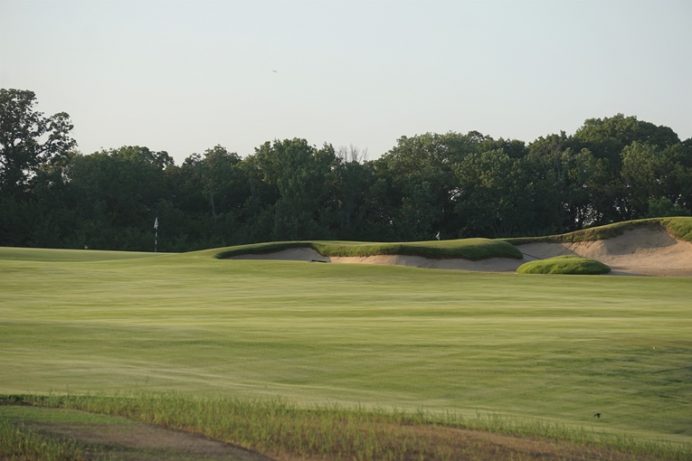
The flag beckons and only one hazard to avoid – what could go wrong?!
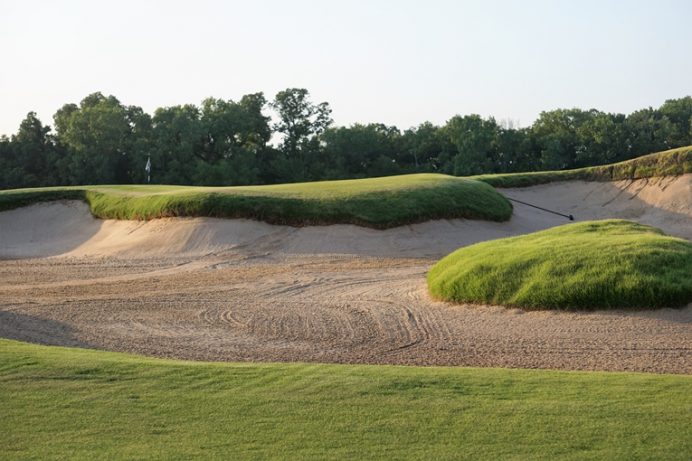
From the blue markers, a carry of 235 yards should see the player past this bunker. Factoring that the tee ball is uphill is an important consideration when weighing choices.
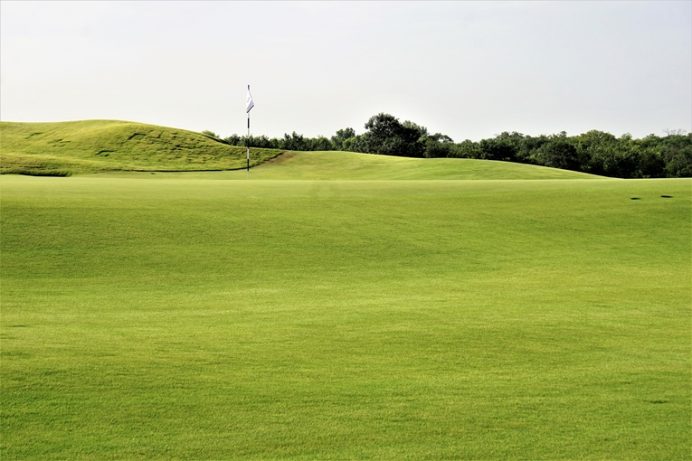
The elevated nature of the domed putting surface is evident from this back left view. Recovery shots of the sort that make Pinehurst No. 2 famous exist in spades, thanks to the tight Trinity Zoysia playing surface.
Sixth hole, 420 yards; A dream design, the exact sort of hole one would hope to find. Two central hazards work in concert with a wide but relatively shallow green to create all sorts of interesting playing angles. The green itself is a marvel, rising up from the fairway in the front before cascading away. Fans of The Old Course at St. Andrews will swoon when they see this one, the similarities are so strong. The ultimate compliment a hole can receive is that members disagree about how best to play. A strong argument can be made that this is an X hole, meaning when the hole is left, the player wants to drive right and vice-versa. Take below as a case study.
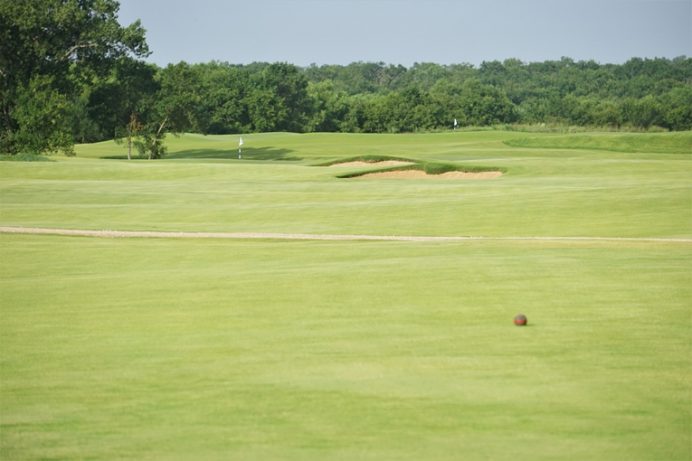
This view from the 6th tee is a reminder that great golf needs to be thought-provoking, though not necessarily dramatic.
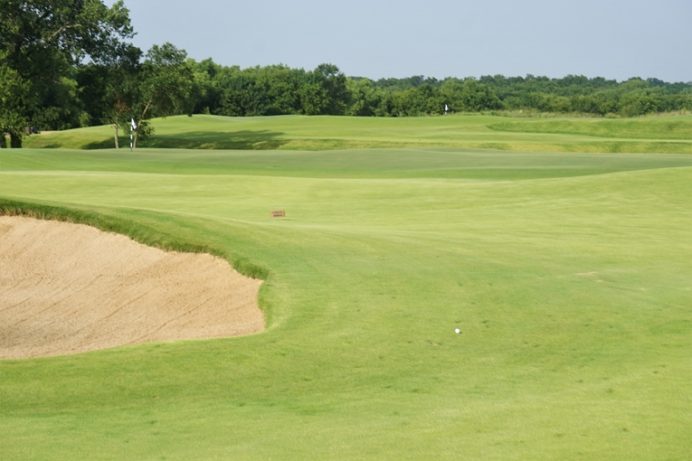
Though the drive is tighter to the central hazard than one may wish, this approach angle from the right has the benefit of providing the player with more green to stop the ball. Plus, the left side wall helps brake an approach shot more so than one played from the left.

This stunning view from behind captures how the green tilts from front to back akin to many of the greens at St. Andrews. It is one of the author’s handful of favorite greens built this century.
Seventh hole, 555 yards; When Coore & Crenshaw completed the course, the first nine was actually the back nine and vice versa. When the PGA Tour came here, they thought that 1) the then eighth and ninth were epic and felt like a seventeenth and eighteenth (in which they were correct) and 2) the last three holes (today’s seventh, eighth, and ninth) could produce swings that were perhaps too wild for a finish (in which they were also correct but why frown on such drama?). Coore tells the story: ‘ The 7th runs beside severe land so we thought we should stretch it around the corner and make it into a risk/reward par 5. In that way, it would be a nice counterbalance to the two shot 4th that runs the other direction along the same dramatic falloff. We wanted our Home hole to be stout, so that only left that back corner for a little one shotter. Both Ben and I were thrilled by the variety and possibilities found in this three hole finishing stretch.’ The PGA felt otherwise, and the nines were reversed, but the Tour’s brief stay here proved something that the members and Coore & Crenshaw already knew – this three shotter is a 3 or 8 hole! Anything can happen and often does. Two well struck draws reward the player with an eagle putt but those draws best not become hooks. The fairway itself has a right to left bias, so the right hand player is already wary about the impact his stance may have on the shot. Making such fiddly adjustments to one’s stance is part of the charm of a round at Trinity Forest, just as it is on a links course. It helps make both experiences just as rewarding the fiftieth time as the fifth.

The high bunker lip before the green is actually 45 paces prior to the start of the putting surface. Carrying that bunker is paramount or like at the 5th, the player is left with one of those miserable ~ 60 yard bunker shots.
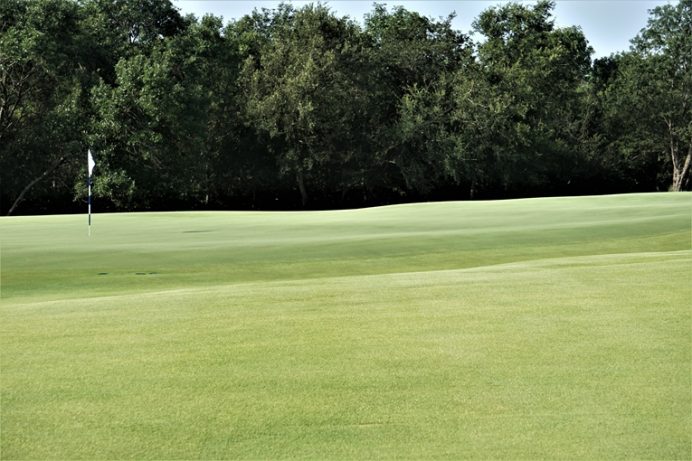
The 7th green is twice as long (50 yards) as it is wide (25 yards) and perfectly hugs the elevated edge of the property. A miss left is death while a miss to the right leaves the golfer with a shallow channel with which he must contend. The slight right to left cant of the putting surface only adds to the tension of trying to get up and down from the right.
Eighth hole, 140 yards; The author had never seen something akin to a double punchbowl green until this one and now he hopes to see many more. What a novel, fabulous idea, and it comes three decades plus deep in the Coore & Crenshaw partnership. To deploy such a green at the end of a monstrously long two shotter might not constitute good golf but to do so at the end of a tiny one shotter is a stroke of genius. According to Coore, ‘We only had room for a tiny one shotter. A pair of bowls could be made out and they provided the inspiration for the putting surface. We couldn’t cut down though and tall tees would be out of place, so the 8th is semi-blind, which adds to the fun.’ Perhaps the thought of a semi-blind, short, one shotter to a wild green as a penultimate hole might have been too much for the Tour but regardless of when one confronts the hole in the round, it is not one that will be forgotten!
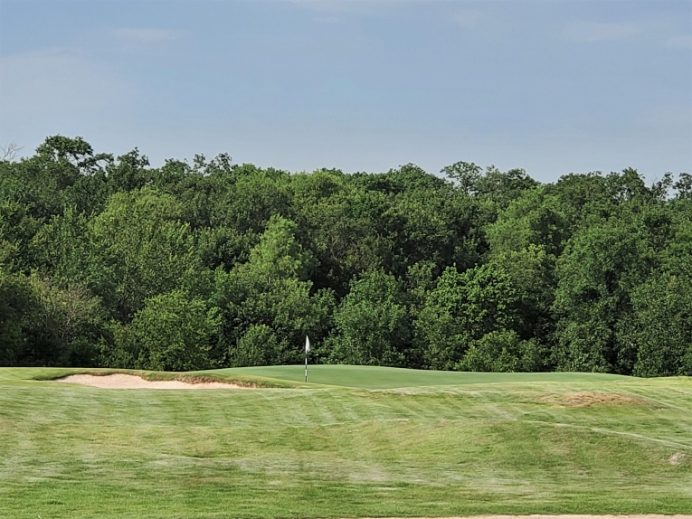
The first curiosity about this tickler is that much of the putting surface is obscured from view from the tee.
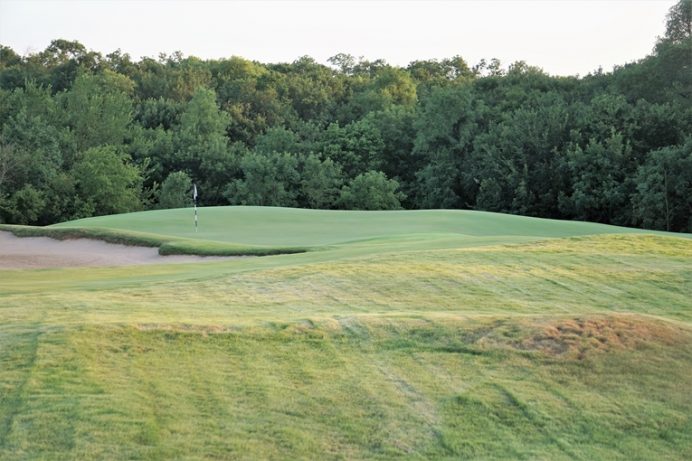
The day’s hole location is in the left bowl while …
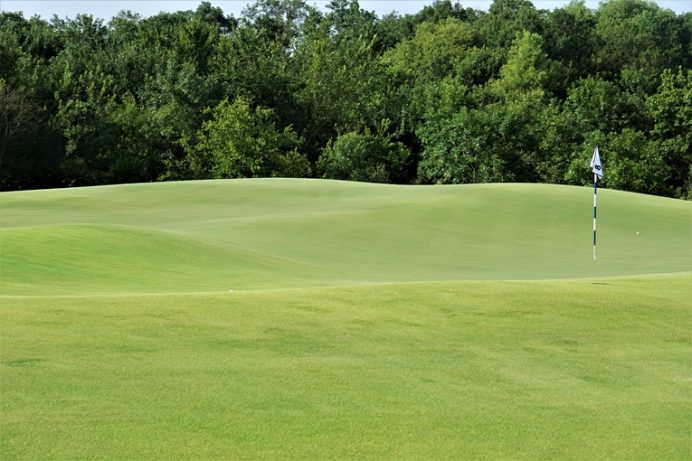
… the next day’s was in the right. There are plenty of ways to get a ball close but if you end up in the wrong bowl, an air of melancholy descends on what is otherwise a very fun playing experience.
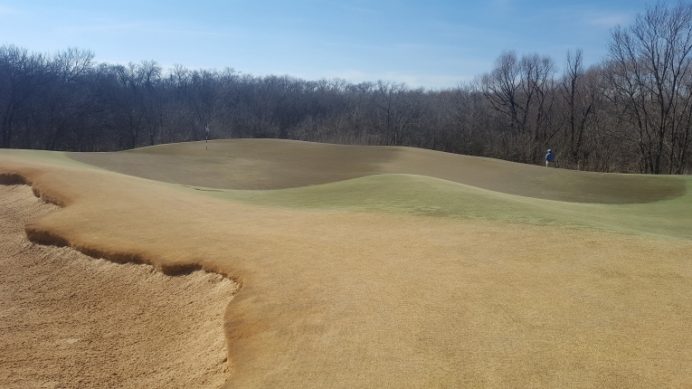
Taken in January when the turf is dormant, the bold green contours are even more starkly evident.
Ninth hole, 465 yards; The chess match between the player and architect continues at the ninth with a central bunker located 130 yards from the front edge of the green. Having gratefully seen his tee ball skirt past this bunker in round one, the player decided in round two not to contend with it. Laying back with a three wood off the tee, he was left with a 50 yard (!) longer approach, that’s how much respect he gave the central bunker. However, the player was arguably too respectful, giving up too much with the three wood. That was the conclusion he arrived at until his driver went into the central feature in round three! So what is the correct play?! The only thing for certain is that firm playing surfaces introduce more confusion and doubt than soft ones. If the fairway was soft, the player could more confidently dial in a tee ball that ends up close to the bunker. As it is, the golfer needs to remain wary, knowing full well that a tee ball might run for 50 yards, stopping only when it plops into a bunker. This is especially true as the hole is played downwind 80% of the time. For the approach, should the player be coming in from 175+ yards and the wind is greater than 10 m.p.h from behind, the line is not the green as the ball will land and assuredly roll off the back slope. Rather, any caliber player must aim at the right edge of the green and use the ground to deaden, or slow down, the ball before then releasing it into the middle of the putting surface. Any player should be content with that outcome on a breezy day. All of this is magnified if the player hits his tee ball tee down the safe, right side of the fairway (away from the hazard) because now the green surround’s pronounced right to left tilt works against the player. Jonas Woods describes the ninth as ‘such a fun challenge’ – and the same applies for the entire course. Indeed, Woods smiles when he hears players who took dead aim at the flag later complain about ‘the bad break’ they received on nine; they simply played the incorrect shot. Trinity Forest tests the golfer’s ability to problem solve like few other American courses – and it takes multiple rounds in all different wind conditions to fully understand the questions being posed.
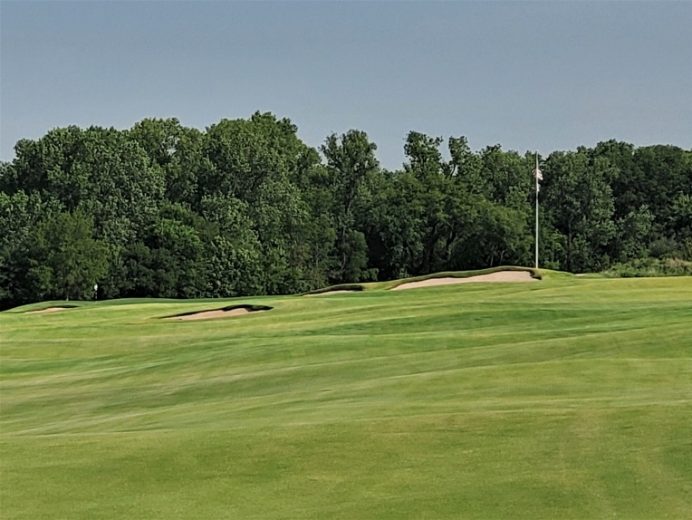
The approach is every bit as interesting as the tee ball. Believe it or not, a draw at the right flag pole might well see the ball finish close to the hole, such is the right to left tilt of the land/green. Additionally, note the wonderful ripples contained within the fairway – such micro-contours are a defining factor at Trinity Forest.
Eleventh hole, 520 yards; Bouncy-bounce playing conditions particularly flourish on 200+ yard shots as there is more time/room for the ball to interact with the ground. The three shot seventh and eleventh holes parallel each other but run in opposite directions so one of them is likely to be reachable on most days. What a delight to witness a bullet three wood land 30-40 yards short of this green, take off, and climb up and over a pronounced knob found at the front of the putting surface. Such a shot simply isn’t supposed to be available in the middle of the United States – but it is here.
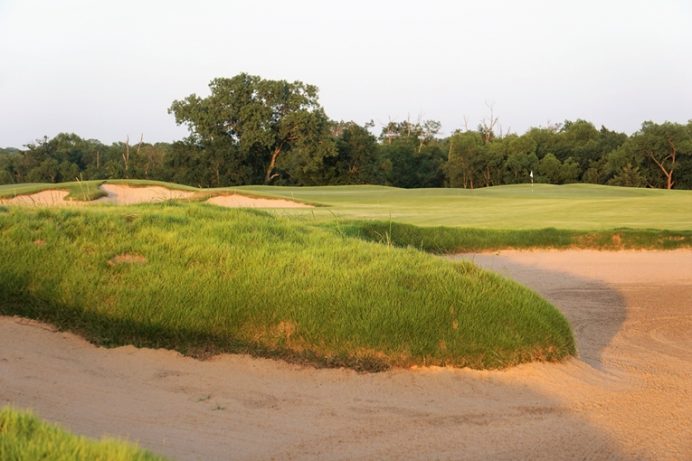
The high knob at the front of the 11th green provides similar attributes to the one that fronts the 14th green on The Old Course at St. Andrews.
Twelfth hole, 205 yards; A perfectly routed hole, with the tee on the west side of a 45 yard wide wash and the green on the east. The hole plays diagonally across it and highlights in technicolor that to successfully play Trinity Forest, one has to aim at point x to end up over by point y. The lowest, least inspired form of golf is when the player is free to (dully) aim straight at a target, knowing the ball will land and obediently sit tight. Golfers can stay on the range to determine who can hit it closest to what flag; there is no charm or thought in doing so. Trinity Forest is at the far end of the spectrum from that mundane golf. The golfer has to continually problem solve, looking for clues well away from the target in order to figure out what sort of shot works best. Here, the green extends in length for nearly 70 yards – and much of it can be used to work tee balls into position below the day’s hole location.
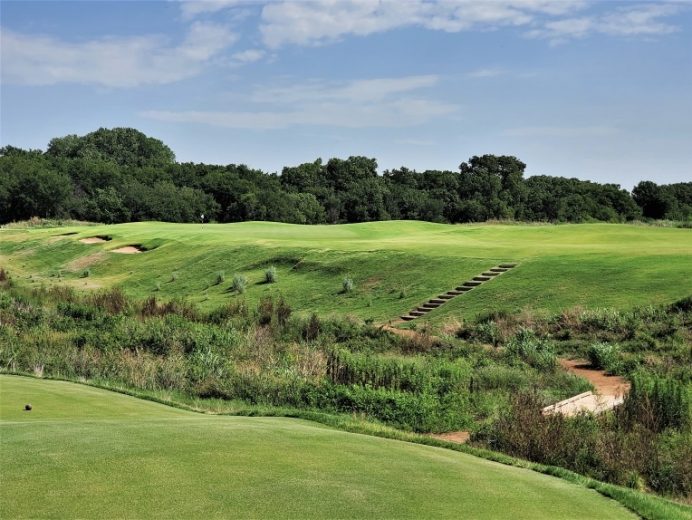
Hard to fathom but the aiming point can be the right edge of the green. One thing is for sure: Any ball that lands left of today’s hole location is guaranteed to finish off the putting surface to the left.
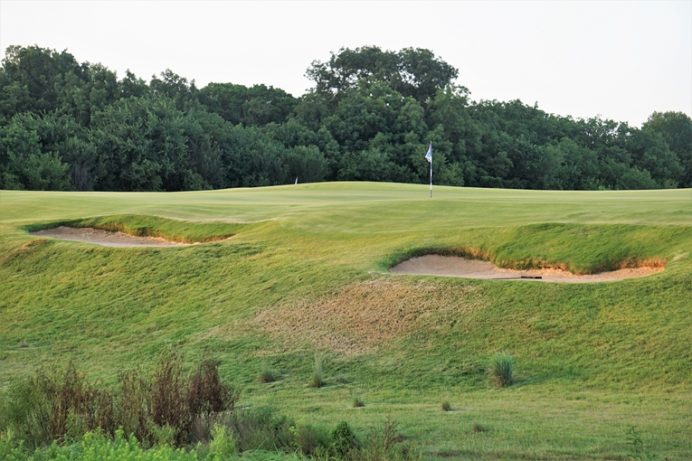
Gravity isn’t the golfer’s friend anywhere along the left of the 12th green. In fact, bunker shots played from here need to land ~20 feet onto the putting surface or the golfer risks seeing the ball return to his feet.
Thirteenth hole, 460 yards; Trinity Forest is a dream design for all ages as a corridor of short grass exists on every non-one shotter from the tee ball landing zone to the putting surfaces – except here where a 40 yard long cross hazard bisects the fairway. How close to edge of the hazard the player can drive the ball is the challenge. Even better, the golfer seeks to position his ball along the left edge of the fairway as the green’s pronounced right to left cant frowns upon shots that hit across it from the right portion of the fairway.
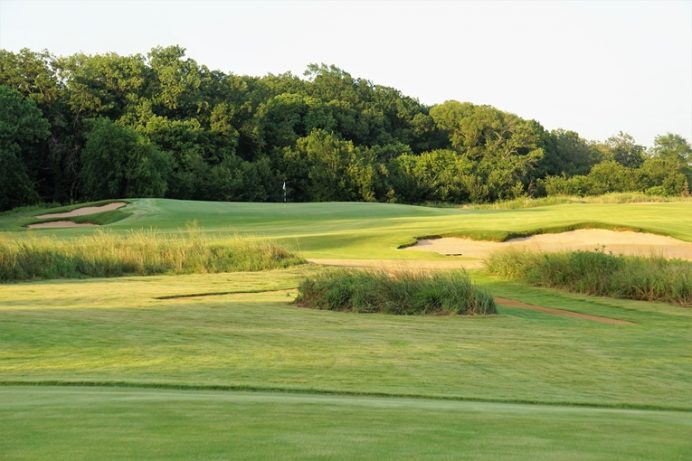
A tee ball long left leaves this reasonable approach shot.
Fourteenth hole, 590 yards; There is no way to step on this tee and not be instantly reminded of the mighty fourth on the West Course at Royal Melbourne with its horizon tee shot needing to clear a large central bunker. In fact, as Bill Coore and Ben Crenshaw were walking the site, they both chuckled when they arrived here as they both instantly knew how Alister MacKenzie would handle this very situation. Beyond the horizon, the greatest change in elevation (50 feet from the peak of the fairway down to the putting surface) is encapsulated within this three shotter. Coore & Crenshaw have always used the length of three shotters to gracefully cover the most dramatic landforms on sites – and this is no exception.

Alister MacKenzie would no doubt approve of this view from the 14th tee. The wind determines whether the player will go left, right, long or short of the central bunker.

The flag is tempting to the right but the golfer needs to head left to find the fairway with his second.
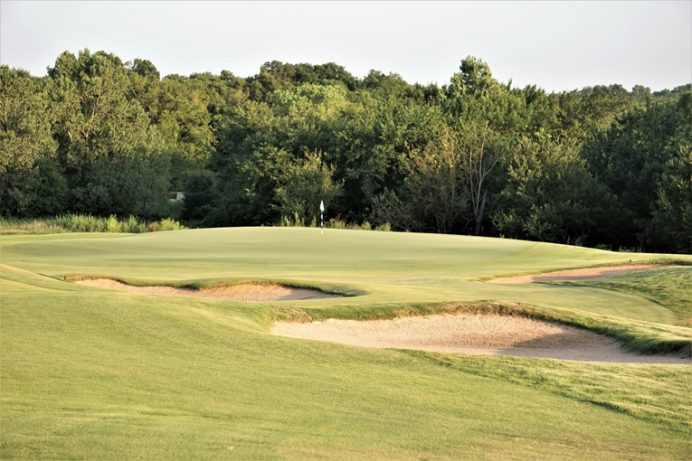
The wedge approach is laid out neatly before the golfer – but that doesn’t make it any easier. Overzealous spin and the soft sides of the putting surface conspire to work against the desired result.
Sixteenth hole, 390 yards; How does each hole enjoy its own voice at Trinity Forest? The answer lies with its greens and indeed how the greens interact with each other. Just look at the final three. Here, the green is pinched in the front by three bunkers before expanding toward the rear. Meanwhile, the seventeenth green is second only to the sixth as the widest putting surface on the course and the axis of the deep Home green is cocked at a 45 degree angle to the fairway. Each green is wildly different to one another, allowing the first timer golfer to vividly recall the playing specifics of each hole well after the round.

The wash that bisects the property acts as the attractive backdrop to the 16th green.
Seventeenth hole, 200 yards; Another hole/green that scores off the charts high marks for originality. In fact, some Coore & Crenshaw devotees put forward this set of one shotters as their best. That’s a big call but just to suggest that a set built on a landfill could rival a collection like those at Lost Farms in the billowing sand dunes of Tasmania is a testament to what was accomplished here. This hole is made by a ‘hot dog’ feature, a long spine that existed exactly where Coore wanted to put the green. To cut it would have required a special permit, then the removed matter would have needed to be bagged, and hauled away in an enclosed truck. It all would have been hugely expensive so Coore just incorporated the feature within the putting surface with stunning success.

The penultimate at sunset. A golfer accustomed to point-to-point golf might take dead aim at the flag while his opponent elects to hit a fade at the left edge of the green and watch the ball go on a ~ 40 yard journey up, then right, and finally down toward the hole.
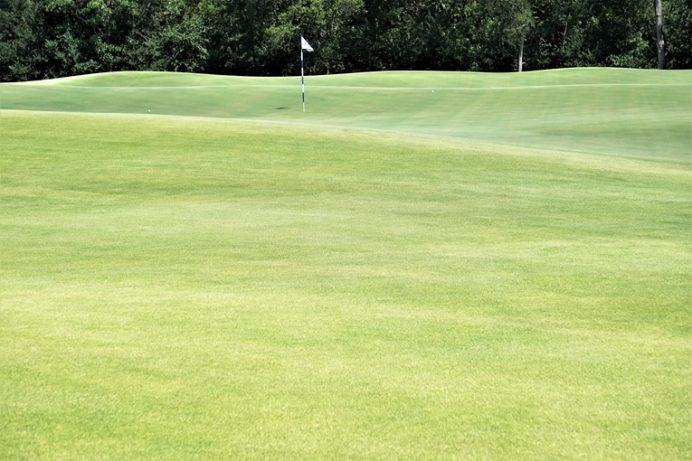
Who builds a 50 yard wide green that mimics rolling ocean waves?! Coore & Crenshaw, and thank goodness for that. The pronounced spine past the hole existed and it became a matter of how to incorporate it within the expansive putting surface.
Eighteenth hole, 485 yards; Even though Coore & Crenshaw built this hole as the ninth, it sure feels like a Home hole, in part because it finishes in front of the luxe, minimalist clubhouse. Three central hazards populate the fairway, each seemingly better placed than the last. Consternation reigns, though the golfer must steady himself quickly for one more smooth swing. The approach perfectly embodies the course’s overarching challenge, namely where pray tell should one look to land his approach to end up by the day’s hole location. As a foil to the ninth, this green features a strong left to right cant and the 50 yard deep green affords numerous vexing hole locations.
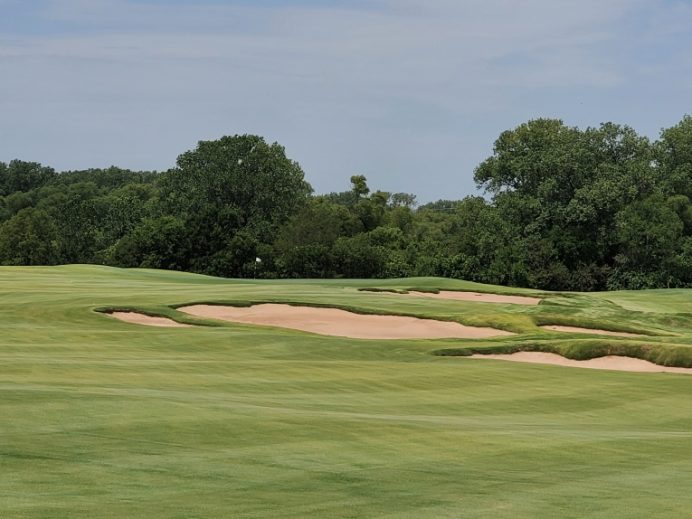
The ideal drive skirts past three central bunkers and leaves the golfer with a reasonable stance and this approach angle. Ideally, the player’s last full shot of the day would deaden into the hillside left and then trickle down to this hole location, a most fitting conclusion to a design that emphasizes the ground game.
What a loss for the PGA Tour to not play here anymore as this course examines so many playing aspects that the other tour stops don’t. With the possible exception of the recently re-grassed Plantation Course at Kapalua (also a Coore & Crenshaw design), no other Tour stop features faster playing surfaces than what Kauff routinely presents here. In short, Trinity Forest represents an entirely different brand of golf from the American norm. The downside is that means that it can be misinterpreted when in fact it should be embraced. With the specter of having bleachers set up for four months now removed, peace and solitude reign. And guess what? The membership completely filled out (even during the pandemic) and the club is bustling with happy members.
The virtues of the course and club were highlighted one evening when a gentleman came in with a small satchel of hickory clubs. The proximity of Trinity Forest to downtown Dallas makes a quick loop in the evenings a distinct possibility. Additionally, the blazing, firm playing surfaces and architecture make the course ideal for hickory golf. And if it is ideal for hickory golf, it is ideal for juniors, seniors, men and women. In short, Trinity Forest is ideal in so many respects – even if there is no reason to think such would have ever been possible. The American maestro Herbert Warren Wind once remarked about Maidstone’s architect Willie Park Jr. that he had a sure touch for ‘devising golf holes that looked natural and played well.’ That quote certainly applies to Coore & Crenshaw and their work at Trinity Forest.




![The Park, West Palm (Lit 9) [2023]](https://golfclubatlas.com/wp-content/uploads/2024/12/IMG_7092-2-scaled-500x383.jpg)



